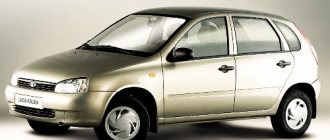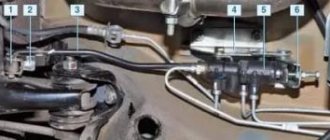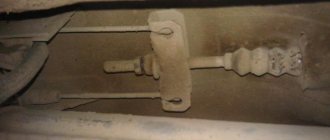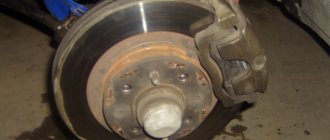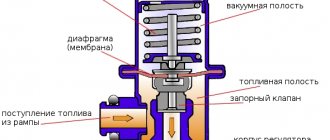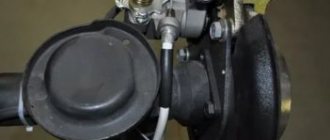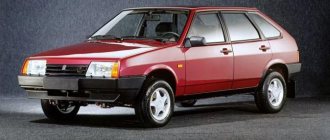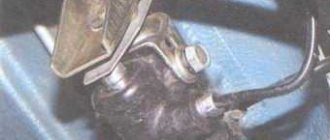On any car, and the Lada Kalina is no exception, there are two on-board power sources - the battery and the generator. The battery is needed to start the engine, but can also be used to provide electricity to consumers when the power unit is not working.
If the engine is running, the generator supplies electricity to the network, and it also charges the battery as needed. Today we will look at a situation where the battery is not charging, which may indicate a whole bunch of malfunctions of varying degrees of severity.
The purpose of the "sorcerer"
The so-called sorcerer on the VAZ-2109 is necessary to automatically change the fluid pressure in the rear brake cylinders depending on the load acting on the car when the speed decreases. This element is used in both hydraulic and pneumatic drive systems.
The main purpose of changing the pressure is to prevent possible wheel locking and skidding of the rear axle of the car.
In some car models, in order to maintain their controllability and stability, a regulator is additionally installed in the brake drive of the front wheels.
In addition, on the VAZ-2109 the sorcerer is used to increase the braking efficiency of an empty car. The traction force of a loaded car and an empty one is different, so the force on different axles must be adjusted. In the case of a loaded and empty machine, static type regulators are used. Automatic solutions are installed in trucks.
In sports cars, manufacturers often install a screw adjuster. It is located inside the car and adjusts the balance of the brake system directly during the race. It is adjusted based on weather conditions, road conditions, and tire quality.
DO NOT JOKE WITH THE BRAKES! — logbook Lada 112 Coupe “crazy car” 2007 on DRIVE2
A couple of days ago I noticed that the brake fluid shortage light was on... so I went and added a little, without giving it any importance... literally the next day the light came on again - and this was already starting to bother me! I didn't want to joke with the brakes at all. I looked at the master cylinder, fittings, all the hoses - everything was dry, without figuring out on my own where the leak was, I went to a car service center, raised the car on a lift and there it was - the sorcerer (brake pressure regulator) was leaking, replaced it, changed the brake fluid and bled the brakes. Of course, they suggested removing it completely, but I think there’s no point and it’s not safe in winter... because then the rear wheels will lock when braking all the time, and you don’t want to somehow see your ass in front of you.
Brake pressure regulator drive for VAZ 2110, VAZ 2111, VAZ 2112 cars:
1 — brake pressure regulator; 2.16 — bolts for fastening the brake pressure regulator; 3 — bracket for the pressure regulator drive lever; 4 — pin; 5 — brake pressure regulator drive lever; 6 — axis of the brake pressure regulator drive lever; 7 — lever spring; 8 - body bracket;9 - brake pressure regulator mounting bracket;10 - elastic lever for the pressure regulator drive;11 - earring;12 - earring bracket;13 - washer;14 - retaining ring;15 - bracket pin;
A, B, C - holes
The brake pressure regulator regulates the pressure in the hydraulic drive of the brake mechanisms of the rear wheels on a VAZ 2110, VAZ 2111, VAZ 2112, depending on the load on the rear axle of the car. The brake pressure regulator is included in both circuits of the brake system, and through the brake pressure regulator, brake fluid is supplied to both rear brake mechanisms.
Issue price: 1,750 ₽
Mechanism design
The Sorcerer is the ancestor of the modern ABS system. It also prevents the wheels on the rear axle from locking during braking.
The device is connected to the rear beam by means of a rod and a torsion lever. This very lever acts on the sorcerer’s piston. The regulator input is connected to the brake master cylinder. The output is connected to the rear working cylinders.
The device consists of a housing, pistons, and valves. The body inside is divided into two cavities. The first interacts with the main brake cylinder. The second is connected to the rear brake mechanisms. When performing emergency braking, when the front part of the car tilts, using pistons and valves inside the regulator, the access of fluid to the rear brake mechanisms is blocked.
Lada Kalina wheel, rim and tire sizes
Lada Kalina is a front-wheel drive car representing the small class.
The model replaced AvtoVAZ's budget products with rear-wheel drive. Its production has been carried out in Tolyatti since 2004. The main competitors of the Lada Kalina model are Daewoo Gentra, Chevrolet Cobalt, Chery Amulet and Lada Granta. In terms of price characteristics, these cars are comparable. Lada Kalina boasts greater maneuverability and smaller dimensions, which allows it to move more confidently in cramped city conditions.
This model has the advantages and disadvantages characteristic of most AvtoVAZ products. The advantages of the car are a wide variety of trim levels, a rigid body, reasonable price, spacious interior and good visibility. The disadvantages include an excessively noisy transmission, low noise insulation in the cabin and not the highest reliability.
Generation 1
The development of the Lada Kalina model began in 1993. In 1998-2000, AvtoVAZ showed prototypes of the car. The official premiere of the product took place only in 2004.
The basic version was the VAZ-1118 sedan. Its production continued until 2009, after which it gave way to the Lada Granta. Since the development of the first generation Lada Kalina lasted almost 10 years, its appearance turned out to be similar to foreign cars of the late 1990s. However, the sedan did not look at all like a “guest from the past.” The exterior of the model looked quite good against the background of domestic cars. True, in the profile of the VAZ-1118 there was clearly a noticeable disproportion between the short, high stern and the small, low hood. The sedan did not create a feeling of heaviness, but it looked too miniature. Small headlights and a radiator grille taken from Priora complemented the image of the city car.
The interior of the VAZ-1118 turned out to be very comfortable using modern materials. The compactness of the car should not be confusing; 5 people could comfortably fit inside it. The trunk of the Lada Kalina sedan was designed for 400 liters.
The model was equipped exclusively with a 1.6-liter unit (80 hp), corresponding to Euro-3.
The hatchback of this series was introduced in 2006. The VAZ-1119 model existed for seven years. The car became a complete copy of the sedan, differing from it only in its shortened length. Such changes affected the free space in the cabin and trunk volume. The Lada Kalina hatchback was positioned exclusively as a city car, and its compactness was seen as a plus, as it allowed it to maneuver on narrow streets. Externally, it looked lighter and faster in comparison with the sedan. In addition to the 1.6-liter engine, the hatchback was equipped with a 1.4-liter unit.
The latest modification of the Lada Kalina was the VAZ-1117 station wagon. It arrived at dealers in 2007. The model had a longer body and increased ground clearance by 25 mm. This allowed her to move more easily on country roads. The remaining technical characteristics of the station wagon completely repeated those of the sedan.
Wheel sizes
- wheels 5J on 13 ET40 (5 – width in inches, 13 – diameter in inches, 40 – positive offset in mm), tires – 175/70R13 (175 – tire width in mm, 70 – profile height in %, 13 – rim diameter in inches);
- 5.5J wheels on 14 ET37, tires – 175/65R14;
- 6J wheels on 14 ET37, tires – 185/60R14;
- 6.5J wheels on 15 ET35, tires – 195/50R15;
- 6.5J wheels on 16 ET45, tires – 195/45R16.
Other wheel characteristics:
- PCD (drilling) – 4 by 98 (4 is the number of holes, 98 is the diameter of the circle on which they are located in mm);
- fasteners – M12 by 1.25 (12 – stud diameter in mm, 1.25 – thread size);
- diameter of the central hole – 58.6 mm;
- tire pressure – 1.9 bar.
Operating principle
During braking, the distance between the axle and the body increases at the rear of the car. As the distance increases, the lever mounted on the bridge releases the sorcerer piston, and it blocks the flow of fluid to the rear brakes. What happens if the fluid can't get to the rear brakes? The wheels will not lock, but will rotate.
In simpler terms, the operating principle of the VAZ-2109 sorcerer is as follows. When the driver pushes hard, the rear of the car will rise. The front one, on the contrary, will go down. This is where the sorcerer begins to work. It will not allow the rear pair of wheels to brake immediately.
The fact is that if the wheels on the rear axle begin to brake along with the front ones, then there is a huge probability that the car will skid. In this regard, the rear brakes will start working a little later than the front ones. The risk of skidding is reduced.
FakeHeader
Comments 24
Consider installing an ABS system on your car so you don't have to deal with this. It’s problematic to adjust it, and no matter how much I tried on the 2108 and 2110, one wheel always overbraked, and sometimes in the summer the butt kicked, but I’m generally silent about the winter!
It was also necessary to add a little more clearance, tedious, but solvable. By the way, yes, for some reason one thing is over-braking
Which one is overbraking you?
Rear right. But it has stopped))) for now it works
what gap did you set? 2 mm or unscrewed two turns?
At first it was 2 mm, then I adjusted it several times, increasing it a little and decreasing it a little. You can't measure it exactly there later. Initially I measured with a drill
It’s clear, I just found three different options for adjusting this particular sorcerer, and it’s not clear which way to adjust. according to the book it is written that the gap should be checked between the sorcerer rod and the lever, on the Internet that between the bolt with a lock nut and the lever, and someone else found a way to set the distance from the lever to the body with a 14mm bolt... how did you adjust?)
Look there, when you press the brake, a rod comes out of the sorcerer, it presses on the pressure plate and together with it they go to the bolt that they rest against, I did 2 mm, pulled the spring-loaded bar with my fingers, and between the rod and the pressure plate it turns out
It’s clear, I just found three different options for adjusting this particular sorcerer, and it’s not clear which way to adjust. according to the book it is written that the gap should be checked between the sorcerer rod and the lever, on the Internet that between the bolt with a lock nut and the lever, and someone else found a way to set the distance from the lever to the body with a 14mm bolt... how did you adjust?)
In any case, you need a hole and try later, there is no other way.
We'll try to figure out what's what)
It was also necessary to add a little more clearance, tedious, but solvable. By the way, yes, for some reason one thing is over-braking
Because the sorcerer itself is not adjusted from the factory.
I removed the large nut, pulled out the spring and stretched it slightly (1-2 turns). I put everything back. Coludn began to work normally.
Yes, I just didn’t regulate it... So I sold it...
You tighten the bolt all the way, and then unscrew it 2 turns and tighten it. There was a 2mm gap on the old “sorcerers”. “Adjust the pressure regulator of the rear brakes of the VAZ Grant Kalina car, for which: - loosen the locking nut 4 and tighten the adjusting bolt 3 until it touches the lever 5 of the pressure regulator piston (wrench 10); 2 — unscrew the adjusting bolt 720° (2 cycles); — fixing the adjusting bolt in the specified location, tighten and tighten the locking nut. Nut tightening torque 6...7 N.m (0.6...0.7 kgf.m) (spanner 10, replaceable insert 10 type 58 23 10 10 f. "Stahlwille", torque wrench type 50 18 00 04 f. " Stahlwille")."
Without a sorcerer
Knowing what the sorcerer's job is on the VAZ-2109, it is not difficult to guess what will happen if it is absent from the brake system. And the following will happen. The car will brake with all four wheels together. The wheels are blocked sequentially - first a pair of wheels on the rear axle, and then the front ones. The risk of an accident increases, since the driver moving behind is unlikely to react in time to a sudden maneuver. A collision will be inevitable.
A sorcerer in the car is very necessary. A VAZ-2109 car without a sorcerer can be very dangerous not only for others on the road, but also for the driver himself. This car is practically uncontrollable in a skid.
Only those who know exactly and understand well what they will get in the end remove the sorcerer. This is mostly done by professional racing drivers.
But some car owners still remove the sorcerer. At the same time, there are even claims that the car began to brake faster and better. Experts say it only seems so. In fact, everything is a little different. The problem here is that in the event of sudden braking, both pairs of wheels will jam in succession.
Typical faults
There are very few malfunctions that occur in this part. These include stuck valves, misalignment, and leaks.
If the sorcerer is upset, he can be adjusted. And they determine whether adjustment is needed by the behavior of the car. If the setting is off, then when braking the car will throw from side to side. If the valves are stuck or the brake fluid is leaking, the part needs to be replaced. Theoretically, repairs are possible, but the complexity and cost make it unprofitable.
The regulator may fail to operate only in two cases - at the maximum possible load and at a speed limit above 80 kilometers per hour. In this situation, the speed does not drop quickly, so the rear axle is not unloaded.
Replacement
Replacing the sorcerer with a VAZ-2109 is performed as follows. You will need a 13 mm wrench, a powerful screwdriver, and a special wrench for unscrewing the brake pipes. Before work, you need to clean the part from rust, pour it with WD-40 or a similar liquid and wait.
You need to start by unscrewing the bolt that secures the bracket to the spring. Then unscrew the brake pipes. Having unscrewed the fittings, unscrew the bolts securing the part to the body and the sorcerer can be removed.
How to repair brake pipes
This process requires the car enthusiast to have extensive locksmith skills and the ability to use special tools. Repairs are carried out in cases where it is not possible to replace the damaged line; it involves saving money on the purchase of a new pipe system and extends the service life of the old one.
To carry out repairs you must:
1. Unscrew the damaged tube from the cylinder or brake caliper.
2. After disconnecting, it is necessary to cut off the damaged area using a pipe cutter.
3. Clamp the tube 50 millimeters from the edge of the cut and chamfer the edge of the tube using a drill.
4. Remove all that remains of the chips and insert a fitting intended for connecting the tube to the brake operating mechanism into the cut area.
5. Insert the end of the tube into the special equipment and flare it. The main line that has undergone repairs must be purged with compressed air. And only after this is it installed with a working mechanism or another pipeline system using an adapter.
As for the length of the tube, this parameter depends on the car model. On some cars, the brake pipes have a reserve that allows you to shorten the pipe and reconnect it to the working mechanism. The metal from which the brake tube is made is flexible, so there should not be any difficulties with its position.
Is a sorcerer really necessary?
If you remove a part from a car, various unpleasant situations may arise. So, a car can brake with four wheels at once, the wheels can be blocked sequentially, and the car will go into a skid.
However, many VAZ owners, when servicing their car, sometimes notice that the sorcerer was removed by the previous owner. Some don't even notice his absence. Others remove it themselves, since it does not work and reduces the effectiveness of the braking system.
The thing is that AvtoVAZ engineers took someone else’s idea and used it to equip domestic cars, but these are completely different cars. Without a doubt, this product is very necessary, but in the case of VAZs it is disposable.
Handbrake
VAZ 2109 brake regulator
- garage room with inspection hole,
- regular set of keys.
- Engage forward gear.
- Place stands under the front wheels for safety.
- The rear suspension of the car must be jacked up and supported with reliable supports.
You need to start by checking the lever, which is located inside the car between the two front passenger seats. Raise it two or three clicks. When raised, one click is made, which means the handbrake cable is tightened. This causes the rear drums to become blocked by the brake pads. If more than 8 are produced, then the cable is weakened and the handbrake does not work:
- With the handbrake on, go down into the inspection hole.
- Loosen the first lock nut on the equalizer.
- Tighten the second nut so that the cable is in a taut position.
- If necessary, on the contrary, release it.
- Check the operation of the lever. It should respond with two or three clicks.
Then tighten the first nut from the hole, tighten with two wrenches to get the effect of tightening two nuts:
- After this, turn off the parking system.
- Check the rotation of the rear wheel rims.
Make rotational movements with your hands. Their rotation should take place without a jerk, calmly scrolling along the axis of the car. The sound should come out rustling. Consequently, the adjustment of the vehicle's brake system was carried out successfully. The vehicle is ready for continued operation. The brakes can also be adjusted in a car workshop. You can entrust this work to specialists. But the motorist experiences reliability when this work is done independently. A car can be considered technically serviceable when it is inspected and repaired independently. He will never let you down in difficult, dangerous times. In addition, the price of repairs at a service station can be high. When doing the work yourself, you need to carefully watch the video. You also need to study the photos and, if necessary, take them to the repair site. Place it on a rack or in the back seat of the car. If necessary, review them again. Read the instructions for the operation and the location of the necessary structures. Finish the adjustment and check the work done on a free asphalt area.
Sorcerer VAZ 2114 operating principle
The sorcerer comes into operation in situations of sharp braking, when the car “nods off”, and the rear part, on the contrary, rises. In this situation, the device temporarily stops the supply of brake fluid to the rear wheels, thereby preventing them from blocking at the same time as the front ones. As a result, the car does not skid. In other words, the device redistributes the braking forces at the required moment. If the sorcerer malfunctions, there is a risk of sending the car into a skid or even overturning during an emergency stop.
How to check the operation of the regulator
To test the operation, at least two people will be required (driver and observer). The driver needs to accelerate in an unloaded car on a flat section of the road up to 60 kilometers per hour, and then brake sharply. At this time, the observer should check the operation of the rear wheels (whether they are locked together with the front ones or continue to spin when the brake is pressed). If the rear wheels lock immediately or continue to spin without responding to the brake pedal, the sorcerer is faulty.
What to do if the battery no charge light comes on
If you find that the battery charge icon on Kalina is lit when the power unit is running, this means that for some reason the generator is not able to provide electricity to the on-board network, so the battery’s electricity supply is consumed to operate the devices.
By and large, further operation of the car with such an error is unacceptable, since one of the reasons for the warning alarm to turn on may be a short circuit. A short circuit, as we know, can lead to a fire in the engine compartment, so the correct course of action is to stop, turn off the engine and try to find the cause of the malfunction.
If it is possible to establish that there is no short circuit, you can continue driving to the garage or service station in order to carry out a full diagnosis in a calm environment.
Replacing the sorcerer on a VAZ 2114
Dismantling and reinstalling a non-working device does not cause significant problems and is accessible to almost anyone. The automaker recommends replacing the faulty regulator assembly. To carry out the work you will need:
- flat screwdriver;
- key to 13;
- 10mm socket for removing brake pipes.
The replacement sequence is as follows:
- We provide convenient access to the rear of the car's underbody (we use a lift, pit, or overpass).
- We find the regulator drive lever. We lift the bracket up and release it. If difficulties arise, use a screwdriver to slightly release the bracket.
- Remove the earring bracket.
- Now we disconnect the four tubes from the body of the product. To do this, you need to loosen and unscrew the fastening nuts. To prevent brake fluid from leaking, plug (seal) the holes of all pipes. In the future, in order not to confuse the connections to the regulator, we mark the 4 pipes with different colors or numbers.
- We unscrew the front bolt of the sorcerer (with which it is attached to the bracket).
- From the side of the bracket, unscrew another bolt.
- Remove the complete device (together with the drive).
- After replacing the product, installation is carried out in the reverse order.
Please note that after reinstallation, the earring fastening bracket must be crimped with pliers. In addition, it is necessary to bleed the brake system and adjust the device for proper operation.
Pedal adjustment
After the inspection, it is necessary to adjust the brake system:
- Raise the hood.
- Disconnect the negative terminal from the battery.
- Move the front driver's seat from the instrument panel all the way to the rear passenger seats. This must be done for easy access under the steering column.
- Hang the prepared lantern in the car to provide sufficient lighting in the area where the adjustment is being made.
Note. Carry out work carefully and consistently.
- Press the brake pedal with the palm of your hand. Press without sharp jolts.
- With your other free hand, try to install the plate in the space from the pedal bracket to the switch button.
If the plate does not enter or if a larger gap of more than 2 mm is detected, the following actions must be taken:
- Hold the pedal with your hand without releasing it.
- With your other hand, using a wrench, slightly unscrew the two nuts along the threads. To loosen the brake warning light switch.
Move it carefully to achieve the required space between it and the brake pedal:
Note: The distance should be no more than 5mm.
- First tighten one nut, then tighten the second.
- Remove your hand from the pedal.
- Check the operations performed.
- The switch buffer rests against the brake pedal bracket, the adjustment is considered complete.
How to adjust the sorcerer on a VAZ 2114
To correctly distribute workloads between front and rear drives, it is necessary to manually adjust the operation of the device. The adjustment principle is as follows. The preliminary gap between the end of the piston and the plate is from two to three millimeters, but in your case this parameter must be determined “experimentally”. To make more precise adjustments, you need to move the regulator along the bracket.
The clearance parameters are selected depending on the behavior of the wheels in each specific case. For example: - There is no skidding of the rear wheels - we reduce the gap. — When triggered early (skidding), we increase the distance.
rav />Neoline CUBEX V50 DVR review – reviews and features
Neoline CUBEX V50 is a fairly expensive DVR that boasts good characteristics and positive user reviews. First of all, you need to pay attention to the type of mounting - the bracket is designed in such a way that it is very easy for the driver to rotate the camera in the vertical and horizontal plane. If you need to quickly remove the camera and capture what is happening on the street, this can be achieved by simply turning the DVR to the side.
A 3-megapixel camera in combination with a powerful Ambarella processor provides good picture quality with a viewing angle of 130 degrees diagonally, that is, not only the roadway, but also the side of the road is captured in the frame. Video recording is cyclic, carried out in small fragments from two to five minutes, even if the power is turned off, the last file will be recorded to the end. In order not to press the buttons on the device body again, you can set the Autostop mode, and the recording will stop as soon as the motor is stopped.
To ensure that all moments are displayed on the video, and the most important recordings are not erased after the memory card is full, there is a G-sensor that can be turned on or off at your discretion. However, a common problem with DVRs on CIS roads is that the shock sensor is too sensitive; it even perceives collisions with bumps or holes as a danger and saves these files in a separate folder, which can only be cleared after removing the memory card.
It’s nice to have a GPS module and the ability to receive GLONASS signals, thanks to which the video displays not only the video sequence itself, but also a map of the route, the speed on a particular section of the route, stamps of the license plates of the cars that were included in the frame, the time and date of recording. In addition, there is still access to the X-COP police radar database. This database includes all stationary installations on the roads of Russia and Belarus; updates occur every two weeks and can be downloaded for free on the manufacturer’s website – Neoline.
“>

